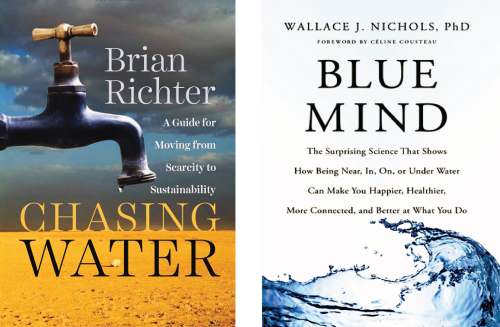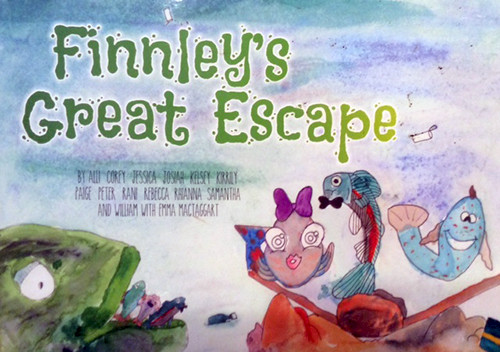Four interesting books from the 2014 International Riversymposium: River Journeys 3, Chasing Water, Blue Mind, and Finnley's Great Escape
Bill Dennison ·One of the interesting things that came out of attending the 17th Annual International Riversymposium was the opportunity to learn about several new relevant books. Last year at the 16th Annual International Riversymposium, I launched the IAN Press eBook 'Dancing with Dugongs: Having fun and developing a practical philosophy for environmental teaching and research' that I co-authored with the late Peter Oliver. This year, I was exposed to four interesting books published in 2014, which are summarized below.
River Journeys 3 was launched at the 17th Annual International Riversymposium, building on the previously published River Journeys (2008) and River Journeys II (2010) books. All three River Journeys books are based on the stories that Riverprize recipients related regarding their environmental management journeys. This started when Jane Thomas and I would interview each of the Riverprize winners at the Riversymposium to get their stories. Various staff from the International Riverfoundation would then take these transcripts, edit them and gather photographs and produce maps to illustrate these uplifting stories. Several other chapters were added to provide context, including a chapter that I authored about the importance of knowledge, passion and persuasive power employed by the recipients. This latest edition of River Journeys is particularly inspiring considering the diversity of amazing stories of people accomplishing demonstrable river protection and restoration at locations around the globe. It was published by the International Riverfoundation.

'Chasing Water: A guide for moving from scarcity to sustainability' by Brian Richter was a new book that Brian highlighted in his plenary talk. This 171 pp. book was published by Island Press in 2014. Brian spends one chapter describing the problem of growing water scarcity and the next seven chapters that comprise the book are focused on outlining practical solutions. Brian draws from 65 case studies from six continents to make his case that water scarcity can be turned into water sustainability. His final chapter entitled 'Chasing Hope' eloquently ends with the statement "It is time to start living within the limits of water's natural availability so that we can reap the benefits of a water-secure future. Because only when we each have enough will we be able to truly appreciate the miraculous fortune of being born on the one blue planet."

A former University of Queensland student, Dr. Karen Arthur introduced me to 'Blue Mind: The surprising science that shows how being near, in, on, or under water can make you happier, healthier, more connected, and better at what you do' by Wallace J. Nichols. Following the Riversymposium, she mailed me this 333 pp. book, published by Little, Brown and Company in 2014. Nichols makes the case that the innate human connection with water is so fundamental that it affects our outlook on life and productivity. He uses many examples, both anecdotal and research-based studies, that support his major tenet that being immersed, near, within sight of water or even viewing a photograph, painting or recalling a memory of water can affect our brains--in a positive manner. I found myself nodding "Yes" as I read this book, and I was adding my own anecdotes of connecting with water, realizing that I, indeed, have a 'Blue Mind'.
My friend Carl Mitchell from the Condamine Alliance gave me a copy of a wonderful new children's book. 'Finnley's Great Escape' is an illustrated children's book written and illustrated by thirteen children, facilitated by Emma Mactaggart from Child Writes. It tells the story of a little Australian smelt named Finnley who, along with several other fish, is exposed to the dangers of polluted water and exotic fish Tilapia species. Finnley and his friends are able to escape with the help of an iconic Murray River cod. I really like to see an outreach program that provides accurate scientific information (dangers of exotic species and pollution to native fish populations) in the right format for the intended audience.

What these four books have in common is hope for a better future. 'River Journeys 3' tells the amazing stories of river restoration from around the globe, 'Chasing Water' outlines practical solutions to water scarcity, 'Blue Mind' identifies our fundamental human connection with water, and 'Finnley's Great Escape' tells the story of danger and salvation of a fish. They embody what is unique about the International Riversymposium--rather than dwell on environmental degradation with a negative and defeatist attitude common to many environmental conferences, the focus of Riversymposium is on the global examples of addressing and solving environmental problems. I can recommend each of these books; you will learn something but you will also feel better after reading them.
About the author
Bill Dennison

Dr. Bill Dennison is a Professor of Marine Science and Vice President for Science Application at the University of Maryland Center for Environmental Science.

